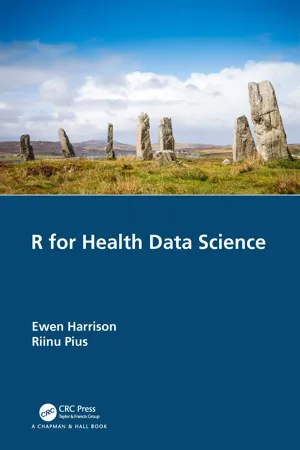
R for Health Data Science
Ewen Harrison, Riinu Pius
- 346 pages
- English
- ePUB (mobile friendly)
- Available on iOS & Android
R for Health Data Science
Ewen Harrison, Riinu Pius
About This Book
In this age of information, the manipulation, analysis, and interpretation of data have become a fundamental part of professional life; nowhere more so than in the delivery of healthcare. From the understanding of disease and the development of new treatments, to the diagnosis and management of individual patients, the use of data and technology is now an integral part of the business of healthcare. Those working in healthcare interact daily with data, often without realising it. The conversion of this avalanche of information to useful knowledge is essential for high-quality patient care.
R for Health Data Science includes everything a healthcare professional needs to go from R novice to R guru. By the end of this book, you will be taking a sophisticated approach to health data science with beautiful visualisations, elegant tables, and nuanced analyses.
Features
-
- Provides an introduction to the fundamentals of R for healthcare professionals
-
- Highlights the most popular statistical approaches to health data science
-
- Written to be as accessible as possible with minimal mathematics
-
- Emphasises the importance of truly understanding the underlying data through the use of plots
-
- Includes numerous examples that can be adapted for your own data
-
- Helps you create publishable documents and collaborate across teams
With this book, you are in safe hands – Prof. Harrison is a clinician and Dr. Pius is a data scientist, bringing 25 years' combined experience of using R at the coal face. This content has been taught to hundreds of individuals from a variety of backgrounds, from rank beginners to experts moving to R from other platforms.
Frequently asked questions
Information
Part II
Data analysis
6
Working with continuous outcome variables
6.1 Continuous data
6.2 The Question
6.3 Get and check the data
Table of contents
- Cover
- Half Title
- Title Page
- Copyright Page
- Dedication
- Preface
- About the Authors
- I Data wrangling and visualisation
- II Data analysis
- III Workflow
- Appendix
- Bibliography
- Index